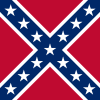

| Online: | |
| Visits: | |
| Stories: |

| Story Views | |
| Now: | |
| Last Hour: | |
| Last 24 Hours: | |
| Total: | |
Liberty: Its True Meaning In Carolina
Here’s a very important excerpt from David Hackett Fischer’s Liberty and Freedom: A Visual History of America’s Founding Ideas:
“In 1776, a powerful British fleet entered the broad reaches of Charleston harbor in South Carolina. Its mission was to return the wayward colony to obedience. Standing between the great ships and their goal were two small palmetto-log batteries called Fort Moultrie and Fort Johnson. The British commanders studied the forts through their telescopes and discovered a strange flag flying above the ramparts. It was the color of indigo, one of the leading crops of the Carolina lowcountry. In the upper corner of the flag was a large white crescent of distinctive shape. Here was yet another emblem of liberty in the American Revolution, and a symbol unique to the Carolina lowcountry …
The heraldic emblem of the younger son had a personal meaning for Carolina families, many of which were founded by younger sons. William Moultrie himself was the younger son of an armigenrous Scottish family. Charles Cotesworth Pinckney, who wore an increscent on his helmet, also came from the line of a younger son who came to America in search of land that was denied to him because of his birth …
The flag itself also made the crescent a symbol of liberty. In South Carolina, this was an idea with a special meaning. It had nothing to do with equality. Like the otium of Virginia’s ruling elite, it was hierarchical and hegemonic. It existed in a world where highborn people had many liberties and defended them fiercely. “Baseborn” folk had few liberties, and slaves had none at all. There was no contradiction if one accepted an assumption of inequality.
The Carolina increscent had another significance. The Latin crescens meant growing or increasing. Like the crescent of a waxing moon, it was a symbol of prosperity and growth. More than that, these meanings were also associated with opportunity and fortune. It became an emblem of success in the present and optimism for the future. It implied that better times laid ahead. The expansive image of Carolina crescent-liberty was a little different from Virginia visions of a Cavalier utopia. But, as we shall see, a symbol of optimism would become a common American association with liberty and freedom …”
In other words, it WAS NOT the “liberty” of liberalism.
The “liberty” that South Carolina was fighting for in the American Revolution had nothing to do with classical liberalism, modern liberalism or libertarianism.
Source: http://www.occidentaldissent.com/2017/04/04/liberty-its-true-meaning-in-carolina/


